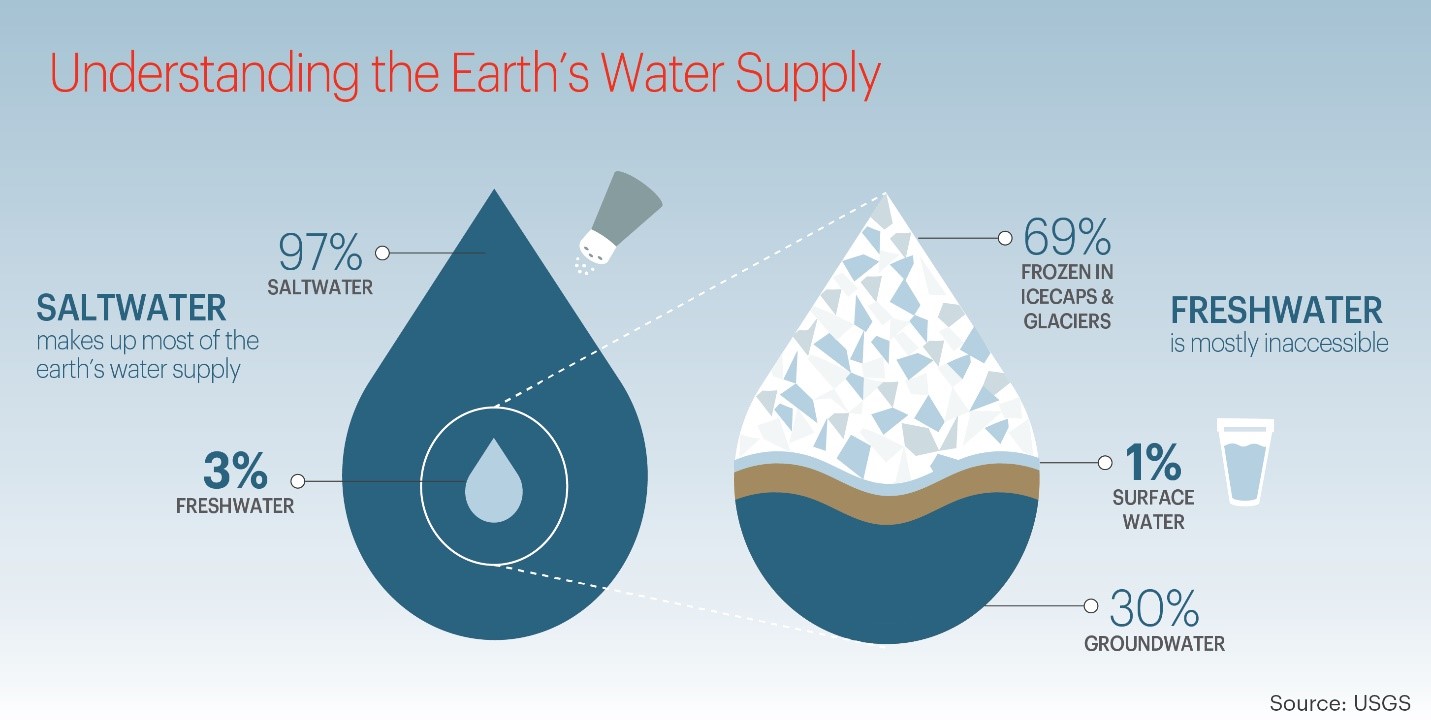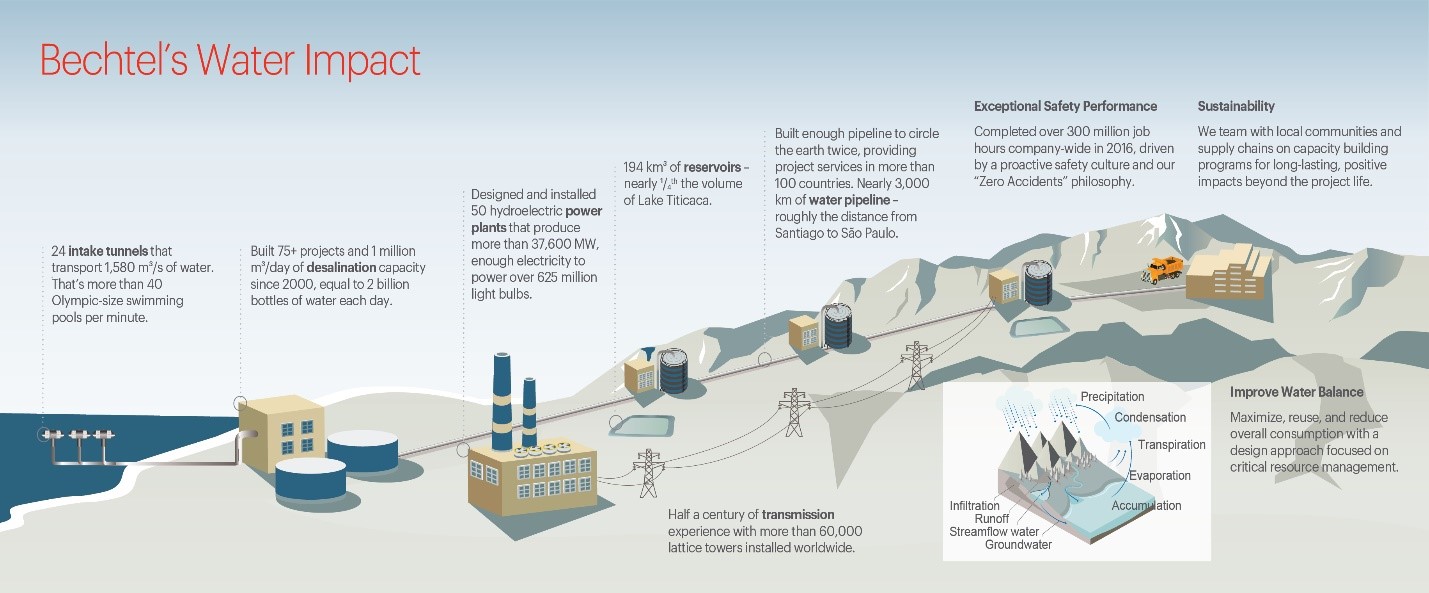As part of Bechtel’s commitment to contribute 100 ideas to support the United Nations 2030 Sustainable Development Goals (SDGs), we examine using desalination to decrease the levels of water stress and release available resources for human consumption.

Sustainability Development Goal #6
By 2030, ensure availability and sustainable management of water and sanitation for all
6.4: By 2030, ensure sustainable withdrawals and supply of freshwater to address water scarcity and substantially reduce the number of people suffering from water scarcity
As part of Bechtel’s commitment to contribute 100 ideas to support the United Nations 2030 Sustainable Development Goals (SDGs), we examine using desalination to decrease the levels of water stress and release available resources for human consumption.
Three out of every 10 people on earth lack access to safely managed drinking water. Today, 2 billion people live in areas of high water stress, where the ratio of freshwater withdrawn to total available freshwater is high. That number is expected to increase to approximately 4 billion, or half the global population, by 2030. Under current climate scenarios, severe water scarcity could potentially displace 700 million people by 2030, increasing the knock-on effects of forced migration. That’s 10 times the current displacement estimates, which are already the highest in human history.
How could that be, when 71% of the earth’s surface is covered by water? Only 3% of the earth’s water is freshwater; the remaining 97% is saline. Of that 3% about 69% is frozen in ice caps and glaciers, 30% is found underground, and 1% is surface water and other freshwater. That means that all of the lakes, swamps, and rivers combined are less than 0.03% of the water on the planet.

The COVID-19 pandemic has highlighted the critical need for water resources for human health, safety, and sanitation, especially in developing economies. Improved water supply is also linked to economic growth and poverty reduction. However, the global water sector continues to be critically underfunded and inefficient. The present value of the investments needed through 2030 to achieve the United Nations Goal 6 of universal and equitable access to safe and affordable drinking water for all is approximately U.S. $1.7 trillion. That is about three times the current allocated investment, worldwide.
Addressing the global water crisis requires interventions across geographies; sectors, such as agriculture, energy, manufacturing; and climate, hydrogeology, and material science disciplines. One potential option to supplement freshwater supply is to look to the sea.
Desalination is the process of removing salts from seawater, or salty (brackish) groundwater, to produce freshwater. Augmenting global desalination capabilities can help reduce the number of people suffering from water scarcity. Desalination, however, is not a novel idea. Distillation systems were used by sailors at sea as far back as the 4th century.
The Industrial Revolution, and specifically steam power, pushed advancements in thermal desalination, which entails salt removal by evaporation. Through the 1920s, desalination was limited to wealthy and water-stressed parts of the Middle East and Caribbean as the process was extremely energy intensive. In 1952, the United States established the Office of Saline Water under the Bureau of Reclamation focusing on research and development in desalination, and water reuse and recycling. Then came the shift from thermal desalination to membrane desalination, due to efficiency. The University of California, Los Angeles developed a Reverse Osmosis (RO) membrane in 1963 that was faster and more efficient than earlier efforts. By the 1970s, desalination capacity increased fivefold and spread to other parts of the world. By the early 2000s, RO membranes were one-tenth the cost and 80% more efficient than earlier prototypes through high efficiency pumps and energy recovery systems.
Even with developments in this technology, only 1% of the world’s drinking water today comes from desalination, according to the International Water Association (IWA). There is potential to increase that percentage and direct it to industrial end users, thereby prioritizing freshwater resources like groundwater and surface water for human consumption. This would provide a drought-proof alternative water supply, while allowing organizations to better manage their existing, lower cost, freshwater resources.
The challenge, however, is that delivering desalinated water remains energy-intensive and costly. Advancements in membrane technology, energy efficiency and energy recovery, and renewable-powered desalination are all promising. Because of the energy intensity, some desalination plants, namely in Australia, have offset their emissions by purchasing renewable energy credits. An example of this is the Victorian Desalination Plant that serves Melbourne, Australia. As desalination membranes must be run continuously, costly preservation requirements must be implemented, therefore energy storage will be key to unlocking renewable-powered desalination.
The cost of desalination can be prohibitive for municipalities. However, there are financing sources that can be leveraged, including Development Finance Institutions and pension funds to address gaps in infrastructure funding.The most water-stressed region in the world, the Middle East and North Africa, has the largest expected economic loss due to water scarcity, estimated at 6 to 14% of GDP by 2050. The value of investing in water infrastructure can greatly outweigh the cost of building it, and that value, along with the life cycle cost of the water asset, needs to be better reflected in investment decisions for water infrastructure, including desalination.
While appreciating the importance of desalination to help address water scarcity, its complexity and environmental impacts must also be adequately addressed. The primary by-product of desalination is brine, a highly saline and dense solution that is difficult to dispose of and can negatively impact coastal environments. There are engineering advancements in filtration, dispersion, and careful disposal or reuse that can help mitigate such impacts. Desalination projects also must adhere to the highest standards of environmental and social safeguards.
How We Can Help
Many of our customers are working to address water scarcity and the effects of climate change. Our expertise allows us to help them address the most challenging aspects of the global water crisis, wherever the effects of scarcity or contamination may be experienced. For example, we have helped Jubail in Saudi Arabia – a 1,106 square kilometer (427 square miles) major industrial and residential complex that accounts for 7% of the country’s GDP – address water scarcity and wastewater issues by implementing a water master plan.
We are also working with Antofagasta Minerals on the Los Pelambres desalination plant in Los Vilos, in northern-central Chile’s Coquimbo Region. The plant will produce 34,500 cubic meters per day (9 million gallons per day) of industrial water as back-up for Los Pelambres in times of particularly acute water scarcity. Bechtel is able to manage interdependent scopes of work, from the marine intake and outfall structures, desalination plant, pumping system, and mining infrastructure, and create integrated design parameters to eliminate interface risk in execution and operations.
We have delivered desalination projects that provide more than one million cubic meters per day (that’s 264 million gallons per day) of desalination capacity installed since 2000 and over 2,200 kilometres (1,367 miles) of pipelines. The combination constitutes what we define as Water Delivery Systems, large scale facilities to treat and transport water over long distances.

The Bechtel approach to desalination is one of process customization. We believe this approach is key in leveraging best-in-class technology for each process stage to best meet the customer’s criteria. The selection criteria often include reliability, operational cost, and recovery rate. This strategy allows our customers to control all aspects of the design and provide them full transparency into the operating parameters that will be experienced over the lifetime of the facility. We offer a technology-agnostic approach and can manage the complexities and interface risks inherent to large desalination projects and associated infrastructure, such as power generation facilities and conveyance systems.
Desalination is by no means a singular solution to the global water crisis, but it can certainly be a critical part of the overall portfolio that would allow municipalities and nations, who are able to leverage the sea, to diversify their portfolio of water resources and provide a drought-proof supplement to their renewable freshwater resources.


